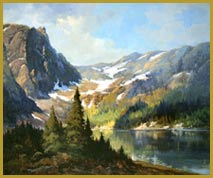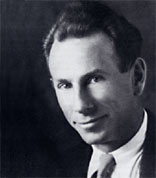 |
 |
|||||||||||||
 |
||||||||||||||
 |
||||||||||||||
|
Robert Wood Master of the American Landscape by Jeffrey Morseburg |
||
|
For
more than sixty years, Robert W. Wood had his finger on the pulse
of American landscape painting. For a number of decades he was America's
best-known landscape painter. From his many trips crisscrossing the American continent, he presented us with a record of the unspoiled American landscape. In a very real sense his paintings are an invaluable document of our rapidly vanishing wilderness and pristine seashores, as only Robert Wood could articulate these themes. Whether it was a marine painting depicting Pt. Lobos, a landscape showing Texas bluebonnets in full bloom, or a view of the Rocky Mountains, Wood handled each of these varied subjects with equal facility. He was aware of the new crosscurrents in American art and had contact with these ideas, but Robert Wood elected to travel a solitary path and stay true to his own vision of what constituted the American landscape. Although he was a prolific painter, it was not Wood's paintings alone that brought him to the attention of the general public. Reproductions of his works found their way into virtually every city and town in the United States and were sold abroad. In fact, the distribution of his work was so complete that one of his dealers from Atlanta used to tell a story about seeing a Robert Wood reproduction in the chief's hut in an African village. By the 1960's, Robert Wood had become famous for the reproductions of his ocean scenes and landscapes which graced the walls of millions of American homes. A reproduction of "October Morn" sold more than 1.25 million copies in less than two years. Robert
W. Wood was born in Sandgate, England, near the famous white cliffs
of Dover, on the coast of Kent. His father, W. L. Wood, was a Victorian
painter and Robert Wood displayed a facility for art at an early
age. As a young man, he studied painting in nearby Folkstone. After
service in the Royal Army, Wood and his friend, Claude Waters, emigrated
to America. Initially, Wood settled in Illinois and worked as a hired hand on a farm belonging to Water's uncle. Then he struck out on his own, living the life of an itinerant painter. He traveled as a hobo, hopping freight trains and selling or bartering small paintings to support himself along the way. When times were hard, he worked at whatever job was available. In this manner, he saw most of the United States and fell in love with rural America. By 1912, he visited Los Angeles for the first time, arriving on the day the Titanic tragedy was featured in the papers. Late in his life, Wood remembered his carefree travels as one of the happiest periods of his life. By the close of 1912, Wood had met, courted and married young Eyssel Del Wagoner in Florida. The couple moved to Ohio where a daughter, Florence, was born. During World War I, the family moved to Seattle where a son, John Robert Wood, was born in 1919. In the early 1920's, the young Wood family was almost constantly on the move. They stayed for short periods in Kansas, Missouri and California and for a longer time in Portland, Oregon, where Wood's friend Claude Waters had settled. Wood's seemingly endless wanderings disrupted his family life and delayed his development as a painter. However, through his travels he developed an appreciation for the American landscape that would inspire him for the rest of his career. Finally finding a place where he felt he could be happy, Wood put down roots in the vast state of Texas. He and his family settled in San Antonio, then the largest city in the state. San Antonio proved to be an ideal location for the young artist, as it offered a great variety of terrains to inspire a landscape painter. It was there that Wood began to pursue painting seriously. Wood studied with Jose Arpa (b. 1868), an academy-trained Spanish artist who was then one of San Antonio's best-known painters. He was also aware of the works of the recently deceased Texas painters Robert and Julian Onderdonk (1853-1917 and 1882-1922 respectively), who were well known for their depictions of the Texan countryside. In a short time, Wood had established a reputation for well-painted landscapes of familiar Texas scenes like the famous fields of Blue Lupin ("Texas Bluebonnets," the state flower) and the Red Oaks found in central Texas. In
1925, Wood was divorced from his wife. In 1932, he moved to the
famous scenic loop on San Antonio's outskirts. During his Texas
period, Wood was very productive. He made sketching trips to the
Rockies, the Grand Tetons, the Cascades, Yellowstone, and the High
Sierras. Wood shipped his paintings to dealers in the South, Midwest
and East, and through them began to build a reputation with collectors
across the country. In San Antonio he met and married his second
wife, Tula. After seventeen years in Texas, Wood pulled up stakes again and established himself in the coastal town of Laguna Beach, California. Laguna had been an artist colony since early in the century and some of the painters of the California Plein-Air School were still active when Wood settled there. In Laguna, he was recognized for his landscapes and marine paintings. For the rest of his career, Wood's paintings of the California coast remained a significant part of his oeuvre. Living in Laguna for seven years, Robert Wood became an active member of the Laguna Art Association and an exhibitor at the annual Laguna Festival of the Arts. Looking for a change of seasons, Wood moved east to the art colony of Woodstock, New York. In Woodstock, Wood painted high-key fall scenes of the forests aglow with bright oranges and reds. His scenes of Woodstock were soon snapped up by the print companies and reproduced in large quantities. Though Woodstock was a popular haven for painters and the surrounding area offered a great variety of subjects to paint, Wood soon tired of living in the East all year. After a few years in New York, Robert and Tula moved back to Laguna Beach. 1952 and 1953 were tumultuous years for Robert Wood. He and Tula became increasingly estranged and were divorced in 1952. The following year, Wood was hit by a car on Pacific Coast Highway and nearly killed. Caryl Price, an amateur artist, helped him around the house during his recovery and the two were soon married. Robert Wood instructed Caryl in painting and took her on sketching trips all throughout the west. During the 1950's, Wood's works became increasingly popular in print and the royalties eventually made him a comfortable living. Through frequent exhibitions and steady print sales Wood's notoriety increased and he found it difficult to keep up with the demand for his original works. In the early 1960's, Robert and Caryl Wood moved to Bishop, at the foot of California's rugged Sierras. Through
the turbulent 1960's, Wood's fame grew and his paintings brought
higher prices, some selling in excess of five thousand dollars.
At the age of eighty, the American Express Company commissioned
him to paint a series of six works to be reproduced as limited edition
serigraphs for their Cardholders. Each print depicted one of the
National Parks, subjects that were well known to Robert Wood. A
few years later, the Woods moved to San Diego, where Caryl restored
the Victorian house that they had purchased. After several years
in San Diego, the Woods made their final move, back to Bishop and
the Sierras. Still active, Robert Wood painted until shortly before
his death in the spring of 1979, just weeks before his 90th birthday. In the history of American Art, Robert W. Wood painted more of the United States than any other painter. He never tired of sketching and many of his small works were "plein-air" (outdoor) sketches done "on the spot." Wood often titled his works with the exact location, date and time of day on the reverse side of the canvas or panel. It was the time that he spent outdoors that imbued his works with the quality of natural light that made them ring true to a wide audience. Robert
Wood was a prolific painter and everything that he painted found
a ready market. He left a legacy of thousands of paintings, for
his career lasted almost seventy years. Most Americans remember
Wood for his later, more impressionistic works, painted when he
led the print market in sales, but many collectors prefer his earlier
works. The paintings from the 1930's and 1940's were generally softer
and more delicate, closer in style to the English landscape painters
of the 19th century than to those of his American contemporaries.
In the 1950's, his work began to take on a looser, more painterly
quality. By the mid-1960's, he was working in a higher key, with
even broader brushwork and bolder colors. It is not difficult to see why Robert Wood's paintings hit a responsive chord in so many viewers. A modest man, Wood did not expend time or energy in promotion or seeking recognition from the critics or the art community. He felt his work spoke for itself and wanted the average person to enjoy his work. To Wood, art was a vocation, not an avocation. He came from the old school where an artist put in countless hours out-of-doors and at his easel to learn his craft, a never-ending process. Today,
those who may have purchased Wood's reproductions twenty or thirty
years ago are now collecting his original works. Collectors who
grew up around Robert Wood's paintings or prints enjoy them because
they are reminded of beautiful locations, pleasant memories and
simpler themes. His works are notable for their truth and clarity.
Robert Wood will always have a place in the hearts of those who
appreciate traditional art and have an affection for the unspoiled
American landscape. Jeffrey Morseburg, a second-generation
art dealer, writes and lectures frequently on the fine arts of the
19th and 20th centuries. He studied art with Theodore N. Lukits
(1897-1992), the academic master and plein-air painter. Morseburg
is on the Advisory Board of the California Art Club, an organization
dedicated to promoting and preserving the works of traditional California
painters of yesterday and today.
|